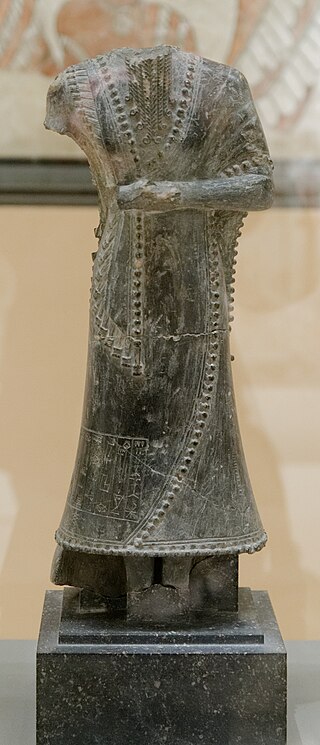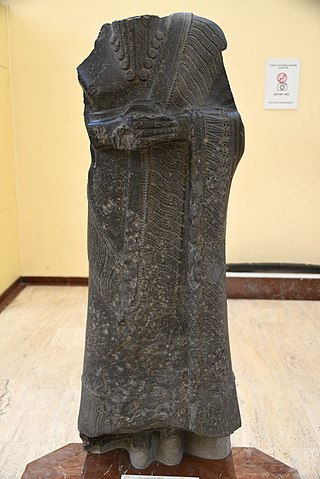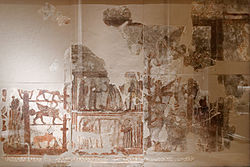The 18th century BC was the century that lasted from 1800 BC to 1701 BC.

In classical antiquity, the cornucopia, from Latin cornu (horn) and copia (abundance), also called the horn of plenty, was a symbol of abundance and nourishment, commonly a large horn-shaped container overflowing with produce, flowers, or nuts.

Yamhad (Yamḫad) was an ancient Semitic-speaking kingdom centered on Ḥalab (Aleppo) in Syria. The kingdom emerged at the end of the 19th century BC and was ruled by the Yamhad dynasty, who counted on both military and diplomacy to expand their realm. From the beginning of its establishment, the kingdom withstood the aggressions of its neighbors Mari, Qatna and the Old Assyrian Empire, and was turned into the most powerful Syrian kingdom of its era through the actions of its king Yarim-Lim I. By the middle of the 18th century BC, most of Syria minus the south came under the authority of Yamhad, either as a direct possession or through vassalage, and for nearly a century and a half, Yamhad dominated northern, northwestern and eastern Syria, and had influence over small kingdoms in Mesopotamia at the borders of Elam. The kingdom was eventually destroyed by the Hittites, then annexed by Mitanni in the 16th century BC.

Lama, Lamma, or Lamassu is an Assyrian protective deity.

The Ishtar Gate was the eighth gate to the inner city of Babylon. It was constructed circa 575 BCE by order of King Nebuchadnezzar II on the north side of the city. It was part of a grand walled processional way leading into the city.
The 1770s BC was a decade lasting from January 1, 1779 BC to December 31, 1770 BC.

Mari was an ancient Semitic city-state in modern-day Syria. Its remains form a tell 11 kilometers north-west of Abu Kamal on the Euphrates River western bank, some 120 kilometers southeast of Deir ez-Zor. It flourished as a trade center and hegemonic state between 2900 BC and 1759 BC. The city was built in the middle of the Euphrates trade routes between Sumer in the south and the Eblaite kingdom and the Levant in the west.

The Burney Relief is a Mesopotamian terracotta plaque in high relief of the Isin-Larsa period or Old-Babylonian period, depicting a winged, nude, goddess-like figure with bird's talons, flanked by owls, and perched upon two lions.

Entemena, also called Enmetena, lived circa 2400 BC, was a son of En-anna-tum I, and he reestablished Lagash as a power in Sumer. He defeated Il, king of Umma, in a territorial conflict through an alliance with Lugal-kinishe-dudu of Uruk, successor to Enshakushanna, who is in the king list. The tutelary deity Shul-utula was his personal deity. His reign lasted at least 19 years.
Ninegal or Belat Ekalli (Belet-ekalli) was a Mesopotamian goddess associated with palaces. Both her Sumerian and Akkadian name mean "lady of the palace."

Zimri-Lim was king of Mari c. 1775–1761 BCE.

The rod-and-ring symbol is a symbol that is depicted on Mesopotamian stelas, cylinder seals and reliefs. It is held by a god or goddess and in most cases is being offered to a king who is standing, often making a sacrifice, or otherwise showing respect. The symbol dates from the Third Dynasty of Ur to the Neo-Assyrian period, and is commonly explained as a coil of measuring string and a yardstick. Other theories are that they are a shepherd's crook and a nose rope, or that the ring is no rope at all.

The Royal Palace of Mari was the royal residence of the rulers of the ancient kingdom of Mari in eastern Syria. Situated centrally amidst Palestine, Syria, Babylon, Levant, and other Mesopotamian city-states, Mari acted as the “middle-man” to these larger, powerful kingdoms. Both the size and grand nature of the palace demonstrate the importance of Mari during its long history, though the most intriguing feature of the palace is the nearly 25,000 tablets found within the palace rooms. The royal palace was discovered in 1935, excavated with the rest of the city throughout the 1930s, and is considered one of the most important finds made at Mari. André Parrot led the excavations and was responsible for the discovery of the city and the palace. Thousands of clay tablets were discovered through the efforts of André Bianquis, who provided archaeologists the tools to learn about, and to understand, everyday life at the palace in Mari. The discovery of the tablets also aided in the labeling of various rooms in terms of their purpose and function.

The art of Mesopotamia has survived in the record from early hunter-gatherer societies on to the Bronze Age cultures of the Sumerian, Akkadian, Babylonian and Assyrian empires. These empires were later replaced in the Iron Age by the Neo-Assyrian and Neo-Babylonian empires. Widely considered to be the cradle of civilization, Mesopotamia brought significant cultural developments, including the oldest examples of writing.

The Statue of Ebih-Il is a 25th-century BC statue of the praying figure of Ebih-Il, superintendent of the ancient city-state of Mari in modern eastern Syria. The statue was discovered at the Temple of Ishtar in Mari during excavations directed by French archaeologist André Parrot. It is made of gypsum, with inlays of schist, shells and lapis lazuli. The statue is displayed in the Musée du Louvre. It has been described as "a masterpiece by virtue of its craftsmanship, state of preservation, and expressive style."

The Statue of Iddi-Ilum is a 21st-century BCE statue of the praying figure of Iddi-ilum, the military governor, or Shakkanakku, of the ancient city-state of Mari in eastern Syria. The headless statue was discovered at the Royal Palace of Mari during excavations directed by French archaeologist André Parrot. The statue was made of soapstone and bears an inscription identifying the figure and dedicating it to the goddess Ishtar or Inanna. The statue is now displayed at the Musée du Louvre in Paris. He was contemporary of the Third Dynasty of Ur, and probably their vassal.

Puzur-Ishtar was a ruler of the city of Mari, northern Mesopotamia, after the fall of the Akkadian Empire. He was contemporary of the Third Dynasty of Ur, and probably their vassal.

Tura-Dagan was a ruler of the city of Mari, northern Mesopotamia, after the fall of the Akkadian Empire. He was son of Apil-Kin, and brother of Ili-Ishar. He held the title of Shakkanakku, which was borne by all the princes of a dynasty who reigned at Mari in the late third millennium and early second millennium BC. These kings were the descendants of the military governors appointed by the kings of Akkad. He was contemporary of the Third Dynasty of Ur, and probably their vassal.
Ḫišamītum or Ḫišametum was a Mesopotamian goddess worshiped in the kingdom of Mari. She was the tutelary deity of the city of Ḫišamta, and it is presumed she originated as a hypostasis of Ishtar. Sacrifices to her are mentioned in various administrative documents from the reigns of kings such as Yaḫdun-Lim and Zimri-Lim. She is also known from letters and a compendium of divination.
Dērītum or Dīrītum was a Mesopotamian goddess associated with Dēr in the kingdom of Mari. While she was originally a hypostasis of Ishtar, she eventually developed into a fully separate deity, and achieved a degree of prominence in the local pantheon during the reign of Zimri-Lim in the 18th century BCE. She is attested in various administrative texts, as well as in personal letters. A celebration focused on her was one of the main festivals in the kingdom of Mari, and participants included both members of the royal family and foreign dignitaries.




















